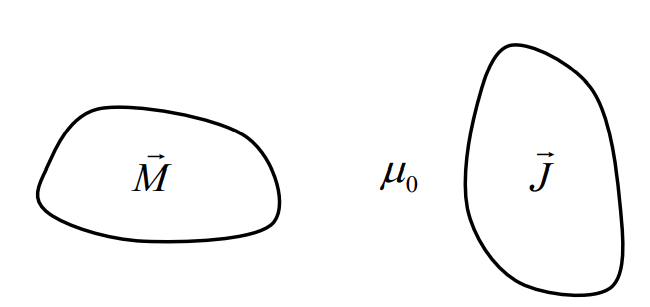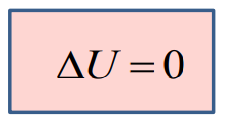
- •Лекция 1. Fundamental concepts of electromagnetics. Electrostatics. (Начало электростатики)
- •Vectors and scalar fields. (Векторные и скалярные поля)
- •Electrostatic field. (Электростатическое поле)
- •Coulomb’s Law. (Закон Кулона)
- •Electric Field Strength e and Displacement Field d. (Напряжённость и смещение электрического поля)
- •Gauss’ Law. (Закон Гаусса)
- •Electric Potential. (Электрический потенциал)
- •Work in the electric field. (Работа в электрическом поле)
- •Dielectric polarization. (Диэлектрическая поляризация)
- •Dielectric material characteristics. (Характеристики диэлектриков)
- •Properties of dielectric materials. (Свойства диэлектрических материалов)
- •Poisson’s and Laplace’ s equations. (Уравнения Пуассона и Лапласа)
- •Лекция 2. Boundary conditions for the Laplace or Poisson equations (Граничные уравнения для уравнений Лапласа и Пуассона)
- •Electrostatic Energy (Электростатическая энергия)
- •Virtual experiment. (Эксперимент по нахождению энергии системы)
- •Consequences (Следствия)
- •Continuity Equation (Уравнение непрерывности)
- •Лекция 3. Static magnetic field (Статическое магнитное поле)
- •Variables and units (Переменные и единицы измерения)
- •Main Relations (Основные соотношения)
- •Magnetic flux density (Индукция магнитного поля)
- •Biot-Savart’s law (Закон Био-Савара)
- •Ampere’s law (Закон полного тока)
- •Scalar magnetic potential (Скалярный магнитный потенциал)
- •The cut in the space (Разрез в пространстве)
- •Laplace equation for the scalar magnetic potential (Уравнение Лапласа для скалярного магнитного потенциала)
- •Vector magnetic potential (Векторный магнитный потенциал)
- •Magnetic flux (Магнитный поток)
- •Differential equation for the vector magnetic potential (Дифференциальное уравнение для векторного магнитного потенциала)
- •Gauging of the vector magnetic potential (Калибровка векторного магнитного потенциала)
- •Integral presentation of the vector magnetic potential (Интегральное представление векторного потенциала)
- •Inductance (Индуктивность)
- •Mutual inductance (Взаимная индуктивность)
- •Inductance of thin contours (Индуктивность тонких контуров)
- •Field intensity inside a cylindrical conductor (Напряжённость поля внутри цилиндрического проводника)
- •Лекция 4. Method of images (метод зеркальных изображений)
- •Equivalent charge density (эквивалентная плотность заряда)
- •Method of images for cylindrical boundaries between dielectrics (метод изображений цилиндрических границ между диэлектриками) Problem formulation (постановка задачи)
- •The inverse point (обратная точка)
- •Normal component of the field intensity (нормальная составляющая напряжённости поля)
- •Geometrical relations (геометрические соотношения)
- •Angles (углы)
- •Field induced by the line sources (поле, индуцированное линейными источниками)
- •The field sources for the external domain (источники полей для внешней области)
- •The field sources for the internal domain (источники полей для внутренней области)
- •Image method for the flat boundary between magnetic media (Метод изображений для плоской границы между магнитными носителями)
- •Equivalent magnetic charge density (Эквивалентная плотность магнитного заряда)
- •Dependence of the field intensity on the coordinate (Зависимость напряжённости поля от координаты)
- •Inductance of the two-wire transmission line per unit length (Индуктивность двухпроводной линии передачи на единицу длины)
- •Total inductance (Общая индуктивность)
- •Forces. The first line. (Силы. 1ая линия)
- •Forces. The second line. (Силы. 2ая линия)
- •Лекция 5. Solution of Laplace’s equation by separation of variables. (Решение уравнения Лапласа методом разделения переменных) Application of Laplace’s equation (Применение уравнения Лапласа).
- •Choice of a coordinate system (Выбор системы координат)
- •Variable separation in cylindrical coordinates (Разделение переменных в цилиндрических координатах)
- •Angular function (Угловая функция)
- •Radial function (Радиальная функция)
- •General solution of the Laplace’s equation in a cylindrical coordinate system (Общее решение уравнения Лапласа в цилиндрической системе координат)
- •Application of the variable separation method for the magnetic field modeling (Применение метода разделения переменных для моделирования магнитного поля)
- •Reduced scalar magnetic potential (Редуцированный скалярный магнитный потенциал)
- •Combination of scalar magnetic potential and reduced magnetic potential (Комбинация скалярного магнитного потенциала и редуцированного магнитного потенциала)
- •The scalar potential induced by the current line (Скалярный потенциал, индуцируемый линией тока)
- •The current potential in the cylindrical coordinate system (Потенциал от линии с током в цилиндрической системе координат)
- •The current potential in the complex plane (Потенциал от линии с током в комплексной плоскости)
- •Expansion of the current potential in the cylindrical coordinate system (Разложение потенциала от линии с током в цилиндрической системе координат)
- •Potentials in the problem domain (Потенциалы в проблемной области)
- •Inductance of the two-wire transmission line per unit length (Индуктивность двухпроводной линии передачи на единицу длины)
- •The flux induced by the magnetized cylinder (Поток, индуцируемый намагниченным цилиндром)
- •Лекция 6. Time dependent electromagnetic fields (Зависящие от времени электрические поля)
- •Faraday’s Law (Закон электромагнитной индукции)
- •Lenz’s Law (правило Ленца)
- •Induction by a temporal change of b (Индукция за счёт временного изменения b)
- •Induction through the motion of the conductor (Индукция за счёт движения проводника)
- •Induction by simultaneous temporal change of b and motion of the conductor (Индукция одновременным изменением во времени b и движением проводника)
- •Unipolar generator (Униполярный генератор)
- •Hering’s paradox (Парадокс Геринга)
- •Periodic electromagnetic field in the conductors. (Периодическое электромагнитное поле в проводниках)
- •Penetration of the electromagnetic field into a conductor. (Проникновение электромагнитного поля в проводник)
- •The skin effect. (Скин-эффект)
- •Poynting’s Theorem. (Теорема Пойнтинга) Electromagnetic Field Energy. (Энергия электромагнитного поля)
- •The rate of decrease of the electromagnetic field energy in a closed volume. (Скорость уменьшения энергии электромагнитного поля в замкнутом объёме)
- •Energy flows in the electromagnetic field (Поток энергии в электромагнитном поле)
- •Transmission of energy in a dc line (Передача энергии в линиях постоянного тока)
- •Transmission of energy in a dc line (Передача энергии в линиях постоянного тока)
- •The field picture near the wires with current (Картина поля вблизи провода с током)
- •Energy flows in static fields (Поток энергии в статических полях)
- •The momentum of the electromagnetic field (Момент электромагнитного поля)
- •The momentum of the electromagnetic field (Момент электромагнитного поля)
- •Лекция 8. Numerical Methods of the Electromagnetic Field Modeling. (Численные методы моделирования электромагнитного поля) Classification of the numerical methods (Классификация численных методов)
- •Classification of the problems (Классификация проблем)
- •Classification of the methods (Классификация методов)
- •Method of moments (Метод моментов)
- •Discretization of the problem domain (Дискретизация проблемной области)
- •Algebraic equation system (Алгебраическая система уравнений)
- •Finite element method (Метод конечных элементов)
- •Discretization (Дискретизация)
- •Finite functions (Ограниченная функция – отлична от нуля только в пределах треугольника)
- •Approximation of functions inside triangles (Аппроксимация функций внутри треугольника)
- •Approximation of the equation (Аппроксимация уравнения)
- •Weighted residual method (метод взвешенных невязок)
- •Galerkin method (метод Бубнова-Галеркина)
- •Weak formulation (ослабленная формулировка)
- •First type boundary conditions (Первый тип граничных условий)
- •The potential and field intensity (Потенциал и напряжённость поля)
General solution of the Laplace’s equation in a cylindrical coordinate system (Общее решение уравнения Лапласа в цилиндрической системе координат)
Combining
the solutions, we will get:
![]()
This function is known as circular (angular) harmonic of order k.
General
solution:

ck, dk, gk, hk – these coefficients correspond to different numbers (different harmonics) of the order of k.
Application of the variable separation method for the magnetic field modeling (Применение метода разделения переменных для моделирования магнитного поля)
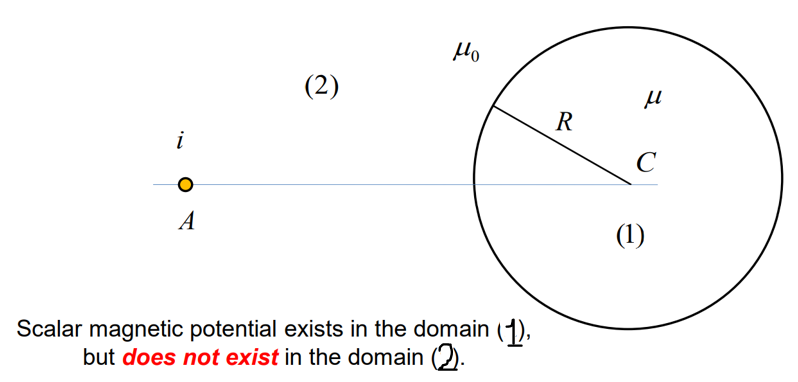
We have a wire with the current and in any case the scalar magnetic potential can’t be used to describe the magnetic field inside the wire. Let’s split our domain in two parts: (1) – the inner part of the cylinder; (2) – everything, which is placed outside the cylinder. (1) – no currents, so we certainly can describe the magnetic field in terms of scalar magnetic potential. We can’t use the scalar magnetic potential in (2), because it doesn’t exist.
Reduced scalar magnetic potential (Редуцированный скалярный магнитный потенциал)
The left domain – ferromagnetic; and the volume (right), where currents induce the magnetic field in the whole space.
|
Magnetic field intensity may be presented as:
|
![]() is the field intensity induced by the current
sources
is the field intensity induced by the current
sources
![]()
![]() is the field intensity induced by the magnetized
objects
is the field intensity induced by the magnetized
objects
![]()
Our problem is linear. It means that μ doesn’t depend on the value of magnetic field intensity, but this principle of superposition is correct for any kind of magnetic system, doesn’t matter isn’t linear or not.
is the potential field:
![]()
A
special potential may be introduced:
![]()
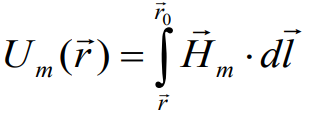
Combination of scalar magnetic potential and reduced magnetic potential (Комбинация скалярного магнитного потенциала и редуцированного магнитного потенциала)
|
|
We should use total magnetic scalar potential inside the magnetized object and everywhere else outside the magnetized object, we can use another presentation of the magnetic field.
Inside
the
 -
domain:
-
domain:
![]() ,
U
is the scalar magnetic potential
,
U
is the scalar magnetic potential
Outside the
- domain:
![]()
The field induced by current sources may be calculated by Biot – Savart Law: |
|

Domain (1) – magnetized object is described by the Laplace equation.
Inside the magnetized domain (1) the scalar magnetic potential satisfies the differential equation
(1):
|
|
In (2) everywhere = 0 = const, that’s why the potential satisfies the Laplace equation.
In the domain (2) the reduced magnetic potential satisfies the differential equation
(2):
![]() This equation is valid in the domain (1) as well.
This equation is valid in the domain (1) as well.
Both equations are the same but the variables are different
|
– is the border of the domain with the magnetized matter Inside the
magnetized domain:
|
Solution of the problem should provide boundary conditions on
![]() (tangential
components of the magnetic field are the same at both sides of this
border)
(tangential
components of the magnetic field are the same at both sides of this
border)
 may be calculated as a gradient of the total
magnetic potential inside the 1st
domain.
may be calculated as a gradient of the total
magnetic potential inside the 1st
domain.
We can consider the magnetic field as a superposition of these two components:
![]()
or:
 ,
,
 -
reduced magnetic potential;
-
reduced magnetic potential;
 – the potential, which is induced by currents (but the currents
can’t be described by the scalar magnetic potential. We consider
the field which is induced by the currents only along the surface ,
but there are no currents along this surface. That’s why in
principle we also can use such an item as scalar magnetic potential
induced by currents.) Of course, this equality also depends on the
choice of points of zero potentials, so it is necessary to choose
properly points with zero potentials. Otherwise, there should be
added some uncertain constant, because potential is defined only with
respect to the uncertain constant.
– the potential, which is induced by currents (but the currents
can’t be described by the scalar magnetic potential. We consider
the field which is induced by the currents only along the surface ,
but there are no currents along this surface. That’s why in
principle we also can use such an item as scalar magnetic potential
induced by currents.) Of course, this equality also depends on the
choice of points of zero potentials, so it is necessary to choose
properly points with zero potentials. Otherwise, there should be
added some uncertain constant, because potential is defined only with
respect to the uncertain constant.
![]()
From the condition for the normal components, we can easily come to the relation for the normal components of the field intensity.

We can use this relation exactly for the magnetic field intensity. It is valid independently on how we defined the magnetic potentials.
Magnetic field of the line current near a magnetized cylinder (Магнитное поле линейного тока вблизи намагниченного цилиндра)

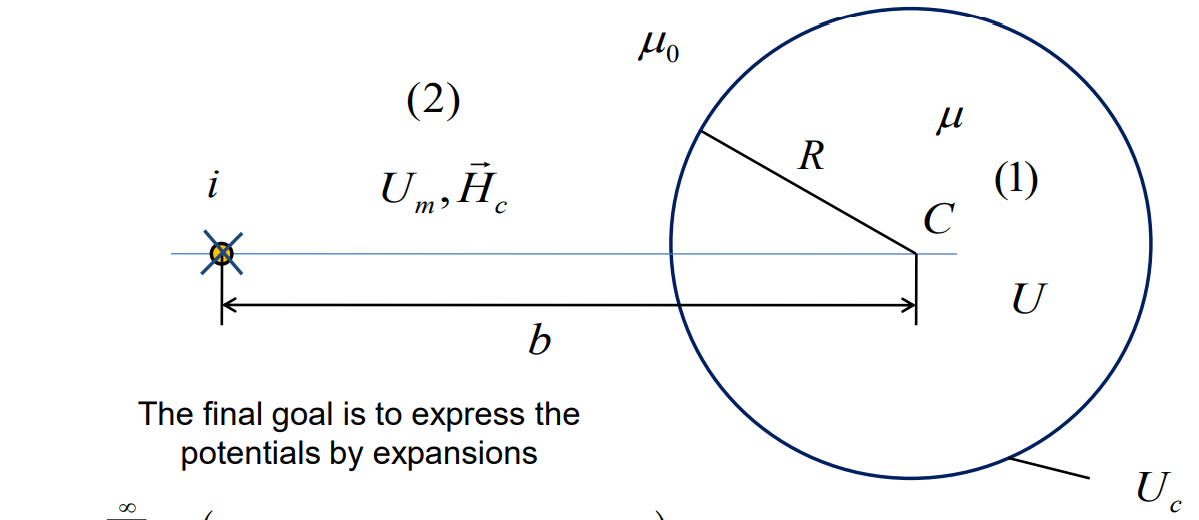
-
general solution The origin of the coordinate system in point C. If
we use a general form of solution, we should substitute radius with
the zero value. In such case the potential will be infinitely big. To
avoid this infinity, we need to assume that the coefficient at the
term of 1/r will be always equal zero. Otherwise, the expression of
the potential simply will not exist (в
итоге получаем
такую шнягу
↓, тут он
объясняет, почему
правая часть
выражения преобразовалась)

Similar
situation is with the presentation of the solution for the reduced
magnetic potential. The radius may be infinitely big. That doesn’t
destroy the solution because this will be one over infinitely big
value in any power =0. But the r = 0 is excluded from the domain (2).
That’s why this term will be never infinitely big.

We should somehow define the constants (g(1)k, h(1)k, g(2)k, h(2)k). First of all, we will start with the question: where the potential is equal to zero. We can choose this point everywhere. But we choose the point with zero potential just at this horizontal line (b). It’s the most convenient choice. But why? Let’s look at general structure of the magnetic field here. We have already known that field along the line will have only a vertical component (see mirror images). So, we can integrate Hdl over the line (b), Hdl – scalar product. We always have zero answer. That’s why all potentials at this line are the same and it’s convenient to choose them to be equal to zero. We will use this choice later to decrease number of unknown coefficients.

